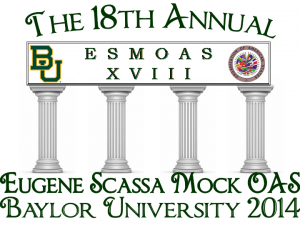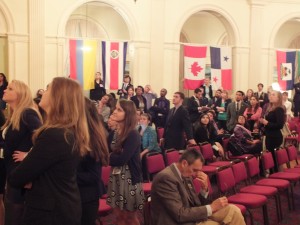This recap was provided by Joshua Hyle, Head Coordinator of the Eugene Scassa Mock OAS conference.
Many Model UN and other model international organizations struggle with two logistical issues when preparing for a conference or competition: recruitment of volunteers, staff, and judges, and adjusting to changes in rules or procedures. The Eugene Scassa Mock Organization of American States (ESMOAS), a regional simulation of the OAS based in Texas, takes a unique approach to meeting these needs.
The ESMOAS is now entering its eighteenth year as a simulation of the Organization of American States, making it the oldest regional-level model of the OAS (the premier international diplomatic organization of the Western Hemisphere, and a precursor to the United Nations). Originally based in San Antonio, Texas as a partnership between local universities and the World Affairs Council of San Antonio, ESMOAS has grown to include universities from across Texas, Oklahoma, Louisiana, Mexico, and beyond. As a result of this growth, the ESMOAS restructured its leadership, putting control of the organization under a faculty Steering Committee with rotating members. Also, rather than being housed at a single university, the ESMOAS decided to rotate hosting duties for its annual conference (in November) and an annual Parliamentary Procedures Workshop (in September) among its participating universities every 2-3 years.
This unique structure has the advantage of keeping institutions involved, but also exacerbated the problem of volunteer recruitment. This was especially true when it came to recruiting qualified judges to adjudicate the competition in November. With a limited budget and a constantly moving location, it became difficult to maintain a reliable network of volunteers and objective judges. This problem was addressed through creating an ESMOAS Alumni Network with three levels of participation. The alumni network, now in place for four years, has revolutionized the way the conference and program are administered, and the way its faculty leadership stay “in touch” with the changing needs of student model participants.
The first tier of this alumni network is actually available to students before graduation. Each participating university is asked to supply one student to a Student Steering Committee. This student may not be graduating, but must be a student returning to the ESMOAS conference the following year. The Student Steering Committee meets immediately after the conference in November and is tasked with suggesting changes, primarily to the schedule and to the Rules of Procedure, for the following year. This meeting is led by the elected Secretary General and the faculty-appointed Parliamentarian, and results in a report submitted to the ESMOAS’s Steering Committee.
The Student Steering Committee gives participating students a voice in how the conference is administered and run, and provides the governing committee valuable feedback on the “ground level”. One of the dangers associated with long-running model programs like ESMOAS and others is that there is a slow but steady divergence between the faculty who make the rules and procedures and the student participants who work within them. If not held in check, rules and logistical decisions can often become out of touch with the realities of the competition, causing the quality of debate to suffer. Keeping students involved in these decisions keeps the model fresh, gives the students a valuable line on their academic resume, and helps the ESMOAS program keep its participating institutions engaged and coming back year after year.
But the student involvement does not end here. After graduating, students whose diplomacy stood out in previous conferences are tapped by the ESMOAS leadership. Select students are asked to serve either as on-site volunteers or, more often, on the Resolution Vetting Committee. When resolutions are submitted for the annual conference, they are divided by committee, have all of their country/authorship information removed, and are sent by email to a member of this committee. Because these students are recent graduates, they are familiar with the form and substance requirements of resolutions (often more so than faculty or program administrators). Also, because the vetting is a “blind” process, students who have just graduated can still provide objective, fair feedback when it comes to approving resolutions for form and substance, or when assigning similar resolutions to working groups. Since the vetting process is done a week before the conference, entirely by email, any graduate can participate, no matter where he or she may have relocated.
Service on the Vetting Committee for at least one year then qualifies alumni to serve as official ESMOAS judges. The Judging Committee is limited to 6-8 members, led by an experienced (usually faculty) Head Judge. Because all the judges have been standout delegates and have also served as resolution vetters, they possess enough knowledge to provide objective and useful feedback to the participating teams. ESMOAS is academically driven, first and foremost, so the quality of judging is a serious consideration. Teams are also provided with written evaluation sheets from the Judging Committee after each conference, allowing faculty and coaches to continue improving their school’s performance from year to year.
The Alumni Network is a win-win solution for conference planners. Students receive valuable experience, recognition at the annual conference and awards ceremony, and an impressive line-item on a resume or c.v. Alumni are provided with the opportunity to stay engaged, and judges’ expenses and lodging are paid for during the conference, allowing them to remain an integral part of the program and give back to future generations of students. Finally, the program itself benefits from having consistent feedback from year to year and having access to knowledgeable, experienced volunteers, resolution vetting, and judges without the exorbitant costs of hiring these individuals from outside the program.
Any academically-based model international organization can utilize parts of the alumni network system to keep students and schools involved, to decrease the costs associated with running an annual conference or competition, or simply to bridge the gap between conference planning and execution. The ESMOAS program office can be reached via email at moascentral@gmail.com and is happy to provide more information to those interested in the program or the logistics of alumni-sourcing. The program’s website can be found here.




